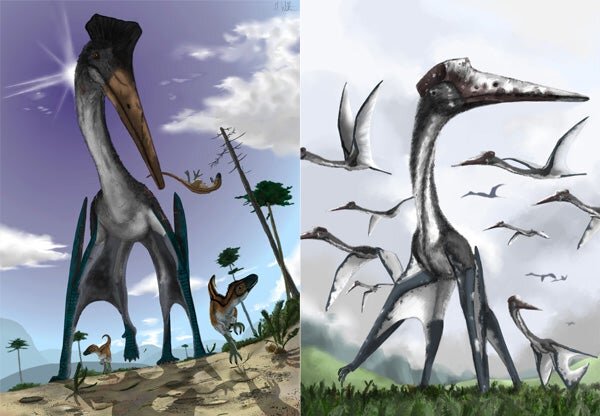About 100 million years ago, gigantic flying reptiles with necks longer than those of giraffes cruised the skies of modern-day Morocco. Scientists think this kind of pterosaur, with its large jaw and slim neck, preyed on fish, small mammals, and even baby dinosaurs. But how their necks didn’t snap as they carried their prey has long been a mystery. Now, a new study shows the bones inside had an intricate spokelike structure that made them strong and stable, but light enough for flight.
Azhdarchid pterosaurs (named after a dragonlike creature in Persian mythology) from Morocco are some of the largest flying animals that ever lived. With wingspans up to 8 meters and necks as long as 1.5 meters, scientists have always wondered how their unusual bodies allowed them to hunt, walk, and fly. “With size comes all kinds of complicated biological problems,” says Nizar Ibrahim, an anatomist and paleontologist at the University of Portsmouth and a study co-author. “How do you build a skeleton for a giant flyer?”
To learn more about their bones, researchers examined the internal structure of a well-preserved azhdarchid pterosaur vertebra; it was nearly 100 million years old, and had been found in the Kem Kem beds, a fossil-rich region near the border of Morocco and Algeria. Using x-ray computed tomography and 3D modeling, the scientists found the vertebra was filled with dozens of 1-millimeter-thick spikes, called trabeculae, crossing each other like the spokes of a bicycle wheel in cross section, and forming a helix along the bone. The spokes surrounded a central tube where the animal’s spinal cord would have been. “We just could not believe it,” says Cariad Williams, a paleontologist at University of Illinois, Urbana-Champaign, who first looked at the scans. “We have never seen anything like it before. … It was really impressive.”
Azhdarchid pterosaurs spent a good part of their time on land hunting small mammals, baby dinosaurs, and fish.
To test whether the spokes provided extra support to the bones, the researchers did some mathematical modeling. They found that as few as 50 trabeculae almost doubled the vertebra’s ability to carry weight, they report today in iScience. The researchers also calculated that the neck of their specimen could lift prey weighing between 9 and 11 kilograms, roughly the size of a large turkey. “It’s a real feat of biological engineering,” Ibrahim says.
Besides allowing the pterosaurs to catch and lift their prey, the intricate bone structure of their necks could have helped them withstand the strong winds that buffeted their large skulls while flying, or the fierce blows of fellow males during rivalry brawls, the authors note.
Many scientists suspected that azhdarchid pterosaurs ate large prey, but this is the first time researchers have tested that hypothesis using information about internal bone structure, says paleontologist Rodrigo Pêgas of the Federal University of ABC, São Bernardo. The analysis the team used to show how the vertebrae would respond to external forces was particularly good, Pêgas says. “It’s interesting that they were able to demonstrate quantitatively … that the animal was capable of lifting [such] prey.”
However, Pêgas wishes the team had scanned the vertebrae of other pterosaurs to find out whether the spokelike bones were unique to the azhdarchids. Alexander Kellner, a paleontologist and director of the National Museum at the Federal University of Rio de Janeiro, agrees. “I’m not very impressed,” he says. “I think you should have more specimens to really make a claim.” He says he has noticed in his research pterosaur vertebrae with more or less trabeculae. Williams says scanning more vertebrae is next on the team’s list.
But finding the right vertebrae could be tough, because fossilized pterosaur bones that retain their 3D structure are rare; Ibrahim notes that the vertebra in the current study is remarkably well preserved. Even so, the researchers are considering several localities where they might find well-preserved pterosaur vertebrae. “When the pandemic is over, we’ll try,” he says.
As much as the new study has revealed, there is still much to learn, Ibrahim says. Many fundamental aspects of azhdarchid biology—even their average weight—remain unknown, he says, because there’s no living creature that compares to these flying reptiles. “This paper serves as a reminder that we’re really just scratching the surface.”









